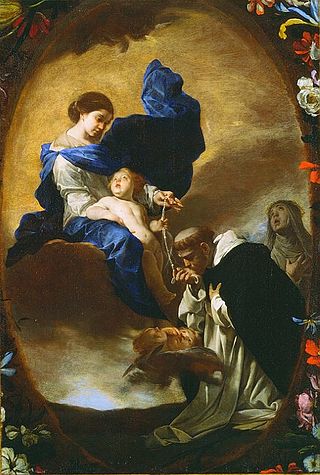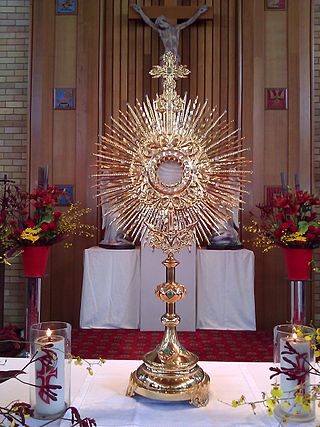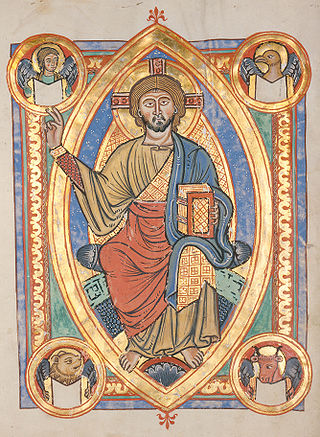Historical background
During the Middle Ages the public functions of the Church and the popular devotions of the people were intimately connected. The laity assisted at the prayer of the Liturgy of the hours, the sacrifice of the Mass, the numerous processions, and were quite familiar with the liturgy. Those few religious practices outside of official services, e.g. the Rosary (a substitute for the 150 Psalms) originated in the liturgy. [7]
Popular piety is an expression of the profound religious feeling of people at a given moment in space and time. The various sets of "Little Offices" (e.g. of the Passion or of the Blessed Trinity), popular from the thirteenth to sixteenth century are now virtually unknown except to museum archivists. [6]
At the beginning of the modern period, "the primacy accorded to contemplation, the importance attributed to subjectivity and a certain ascetical pragmatism exalting human endeavour ensured that Liturgy no longer appeared as the primary source of the Christian life in the eyes of men and women advanced in the spiritual life." The reform of the Roman liturgy after the Council of Trent brought advantages such as ensuring that the doctrinal content reflected the faith in its purity, but its new fixity made it seem the reserve of the clergy and reinforced a division between liturgy and popular piety. [9]
Popular devotion then followed its own channels, especially since the 16th century. Non-liturgical practices like the Stations of the Cross, the Forty Hours' Devotion, various litanies and rosary-based prayers and chaplets prevailed everywhere; novenas and series of Sundays and weekdays in honour of particular saints or mysteries were instituted. Entire months of the year were given over to special devotions, the most widespread being: January (Holy Name of Jesus); March (Saint Joseph); May (Virgin Mary); June (Sacred Heart); July (Precious Blood); September (Our Lady of Sorrows); October (Rosary); November (Souls in Purgatory). [7]
A renaissance of liturgical worship began in the late 19th century and was advanced by the reforms of Pope Pius X and his 20th-century successors.
Relation to the liturgy
The Second Vatican Council asked that popular Catholic devotions "should be so drawn up that they harmonize with the liturgical seasons, accord with the sacred liturgy, are in some fashion derived from it, and lead the people to it, since, in fact, the liturgy by its very nature far surpasses any of them." [11]
The Catholic Church has declared popular piety "a true treasure of the People of God" [12] and decried the attitude of "certain persons concerned with the care of souls who scorn, a priori, devotions of piety which, in their correct forms, have been recommended by the magisterium, who leave them aside and in this way create a vacuum which they do not fill." [13] Furthermore, the heretofore mentioned Directory declares that manifestations of popular piety "are subject to the jurisdiction of the local ordinary. It is for him to regulate such manifestations, to encourage them as a means of assisting the faithful in living the Christian life, and to purify and evangelize them where necessary." [14]
In application of this principle, members of the Church, clergy or laity, individuals or groups, must obtain the local ordinary's permission to promote prayers, formulas or private initiatives in this field. On a level beyond the confines of single dioceses, competence belongs to the Congregation for Divine Worship and the Discipline of the Sacraments. [15]
Practices of popular piety
The Directory on popular piety and the liturgy devotes separate chapters to consideration of practices associated with the liturgical year, such as processions, the Way of the Cross or the crib, the veneration of the Mother of God, the veneration of the other saints, beatified and the holy angels, the suffrage for the dead, as well as shrines and pilgrimages.
Under the heading The language of popular piety, it speaks of gestures, texts and formulae, song and music, sacred music, sacred places and sacred times.
For an overview of some practices that form part of Catholic popular piety, see Catholic devotions.

Sacrosanctum Concilium, the Constitution on the Sacred Liturgy, is one of the constitutions of the Second Vatican Council. It was approved by the assembled bishops by a vote of 2,147 to 4 and promulgated by Pope Paul VI on 4 December 1963. The main aim was to revise the traditional liturgical texts and rituals to reflect more fully fundamental principles, and be more pastorally effective in the changed conditions of the times, clarifying not only the role of ordained ministers but the modalities of appropriate participation of lay faithful in the Catholic Church's liturgy, especially that of the Roman Rite. The title is taken from the opening lines of the document and means "This Sacred Council".

The Rosary, formally known as the Psalter of Jesus and Mary, also known as the Dominican Rosary, refers to a set of prayers used primarily in the Catholic Church, and to the physical string of knots or beads used to count the component prayers. When referring to the prayer, the word is usually capitalized ; when referring to the prayer beads as an object, it is written with a lower-case initial letter.

Piety is a virtue which may include religious devotion or spirituality. A common element in most conceptions of piety is a duty of respect. In a religious context, piety may be expressed through pious activities or devotions, which may vary among countries and cultures.

Worship is an act of religious devotion usually directed towards a deity or God. For many, worship is not about an emotion, it is more about a recognition of a God. An act of worship may be performed individually, in an informal or formal group, or by a designated leader. Such acts may involve honoring.

Liturgy is the customary public ritual of worship performed by a religious group. As a religious phenomenon, liturgy represents a communal response to and participation in the sacred through activities reflecting praise, thanksgiving, remembrance, supplication, or repentance. It forms a basis for establishing a relationship with God.

Eucharistic adoration is a devotional practice primarily in Western Catholicism and Western Rite Orthodoxy, but also to a lesser extent in certain Lutheran and Anglican traditions, in which the Blessed Sacrament is adored by the faithful. This practice may occur either when the Eucharist is exposed, or when it is not publicly viewable because it is reserved in a place such as a tabernacle.
Christian liturgy is a pattern for worship used by a Christian congregation or denomination on a regular basis. The term liturgy comes from Greek and means "public work". Within Christianity, liturgies descending from the same region, denomination, or culture are described as ritual families.

A sacramental is a sacred sign, a ritual act or a ceremony, which, in a certain imitation of the sacraments, has a spiritual effect and is obtained through the intercession of the Church. Sacramentals surround the sacraments like a wreath and extend them into the everyday life of Christians. Sacramentals are recognised by the Roman Catholic Church, the Eastern Orthodox Church, the Oriental Orthodox Churches, the Church of the East, the Lutheran churches, the Old Catholic Church, the Anglican churches, and Independent Catholic churches.

In Christianity, worship is the act of attributing reverent honour and homage to God. In the New Testament, various words are used to refer to the term worship. One is proskuneo which means to bow down to God or kings.

Eucharistic discipline is the term applied to the regulations and practices associated with an individual preparing for the reception of the Eucharist. Different Christian traditions require varying degrees of preparation, which may include a period of fasting, prayer, repentance, and confession.

Marian devotions are external pious practices directed to the person of Mary, mother of Jesus, by members of certain Christian traditions. They are performed in Catholicism, High Church Lutheranism, Anglo-Catholicism, Eastern Orthodoxy and Oriental Orthodoxy, but generally rejected in other Christian denominations.

Catholic liturgy means the whole complex of official liturgical worship, including all the rites, ceremonies, prayers, and sacraments of the Church, as opposed to private devotions. In this sense the arrangement of all these services in certain set forms is meant. Liturgy encompasses the entire service: prayer, reading and proclamation, singing, gestures, movement and vestments, liturgical colours, symbols and symbolic actions, the administration of sacraments and sacramentals.

Catholic devotions are particular customs, rituals, and practices of worship of God or honour of the saints which are in addition to the liturgy of the Catholic Church. The United States Conference of Catholic Bishops describes devotions as "expressions of love and fidelity that arise from the intersection of one's own faith, culture and the Gospel of Jesus Christ". Devotions are not considered part of liturgical worship, even if they are performed in a church or led by a priest, but rather they are paraliturgical. The Congregation for Divine Worship at the Vatican publishes a Directory on Popular Piety and the Liturgy.

Anglican devotions are private prayers and practices used by Anglican Christians to promote spiritual growth and communion with God. Among members of the Anglican Communion, private devotional habits vary widely, depending on personal preference and on their affiliation with low-church or high-church parishes.

Prayer in the Catholic Church is "the raising of one's mind and heart to God or the requesting of good things from God." It is an act of the moral virtue of religion, which Catholic theologians identify as a part of the cardinal virtue of justice.
Mediator Dei is a papal encyclical issued by Pope Pius XII on 20 November 1947. It was the first encyclical devoted entirely to liturgy.

Marialis Cultus is the title of a Mariological apostolic exhortation by Pope Paul VI issued on February 2, 1974. It is subtitled: "For the Right Ordering and Development of Devotion to the Blessed Virgin Mary", and discusses Marian devotions, clarifying the way in which the Roman Catholic Church celebrates and commemorates Mary, the mother of Jesus. The exhortation sought to integrate devotion to Mary into the pastoral catechetical process, especially in liturgical catechesis, in a manner harmonious with the reforms of Vatican II. Mary must always be understood in relation to Jesus.

The veneration of Mary in the Catholic Church encompasses various devotions which include prayer, pious acts, visual arts, poetry, and music devoted to her. Popes have encouraged it, while also taking steps to reform some manifestations of it. The Holy See has insisted on the importance of distinguishing "true from false devotion, and authentic doctrine from its deformations by excess or defect". There are significantly more titles, feasts, and venerative Marian practices among Roman Catholics than in other Western Christian traditions. The term hyperdulia indicates the special veneration due to Mary, greater than the ordinary dulia for other saints, but utterly unlike the latria due only to God.

The Roman Catholic tradition includes a number of devotions to Jesus Christ. Like all Catholic devotions, these prayer forms are not part of the official public liturgy of the church but are based on the popular spiritual practices of Roman Catholics. Many are officially approved by the Holy See as suitable for spiritual growth but not necessary for salvation.
Protestant liturgy or Evangelical liturgy is a pattern for worship used by a Protestant congregation or denomination on a regular basis. The term liturgy comes from Greek and means "public work". Liturgy is especially important in the Historical Protestant churches, both mainline and evangelical, while Baptist, Pentecostal, and nondenominational churches tend to be very flexible and in some cases have no liturgy at all. It often but not exclusively occurs on Sunday.

















